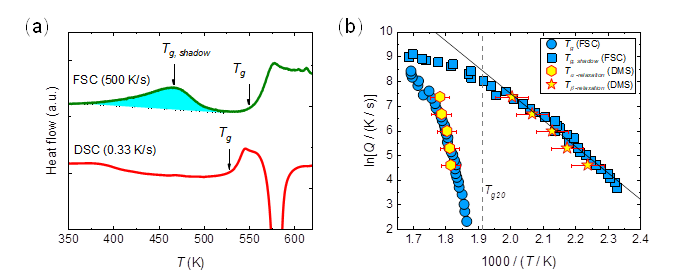
Figure Shadow glass transition phenomenon in Pd40Cu40P20metallic glass (a), and its relationship with β relaxation (b).
(National Science Review 2020, DOI: 10.1093/nsr/nwaa100)
Background
As time or temperature changes, the microstructure of amorphous materials will slowly evolve, this process is called “relaxation” and is a key factor in understanding the transition dynamic of amorphous matters. Complex relaxation processes are shown in different time-scales and temperature ranges for glass materials, such as α relaxation and β relaxation. The α relaxation is a large scale irreversible structural rearrangement of glass-forming liquids, and is responsible for the glass transitionsphenomenon. Subsequently, α relaxation is frozen when the temperature is below the glass transition temperature, so the β relaxation becomes main relaxation and the principal source of dynamics in the glassy state. In recent years, studies have shown that β relaxation and α relaxation are closely related. However, the study of the relationship between the two relaxation process and their physical nature is still a big challenge in glass community. On the other hand, when heated from low temperature (i.e. by differential scanning calorimetry) they exhibit complex relaxation processes before the glass transition temperature, including the exothermic enthalpy relaxation peak and the annealing-induced endothermic peak, the latter is also known as the shadow glass transition. These processes are of great significance to the understanding of glass physics. However, their physical nature is still unclear, especially for the shadow glass transition.
What did we discover?
Here, with the chip-based fast scanning calorimetry, we study the dynamics of the shadow glass transition over 4 orders of magnitude in heating rates for 24 different metallic glasses.We present evidence for that the shadow glass transition correlates with the secondary (β) relaxation: (i) The shadow glass transition and the β relaxation follow a same temperature - time dependence, and both merge with the primary relaxation at high temperature. (ii) The shadow glass transition is more obvious in glasses with pronounced β relaxation, and the vice versa; their magnitudes are proportional to each other. Our findings suggest that the shadow glass transition signals the thermodynamics of β relaxation.
Why is this important?
The β relaxation and shadow glass transition are strongly correlated with many unresolved issues of glassy physics and materials science. Therefore, it is important to explore the relationship between them. Our current results provide clear evidence for the correlation between the shadow glass transition and the β relaxation. The current work is not only helping us to better understand the nature of shadow glass transition and β relaxation behavior, but also overcomes the shortcomings of traditional calorimetric methods that cannot detect the β relaxation behavior of amorphous materials. More importantly, this work also established the connection between glass dynamics and thermodynamics, which is of great significance to the study of glass physics.
Who did the research?
Qun Yang1, Si-Xu Peng1, Zheng Wang2,*and Hai-Bin Yu1,*
1Wuhan National High Magnetic Field Center and School of Physics, Huazhong University of Science and Technology, WuHan 430074, China.
2Key Laboratory for Liquid-Solid Structural Evolution and Processing of Materials (Ministry of Education), Shandong University, Jinan 250061, China
https://doi.org/10.1093/nsr/nwaa100
